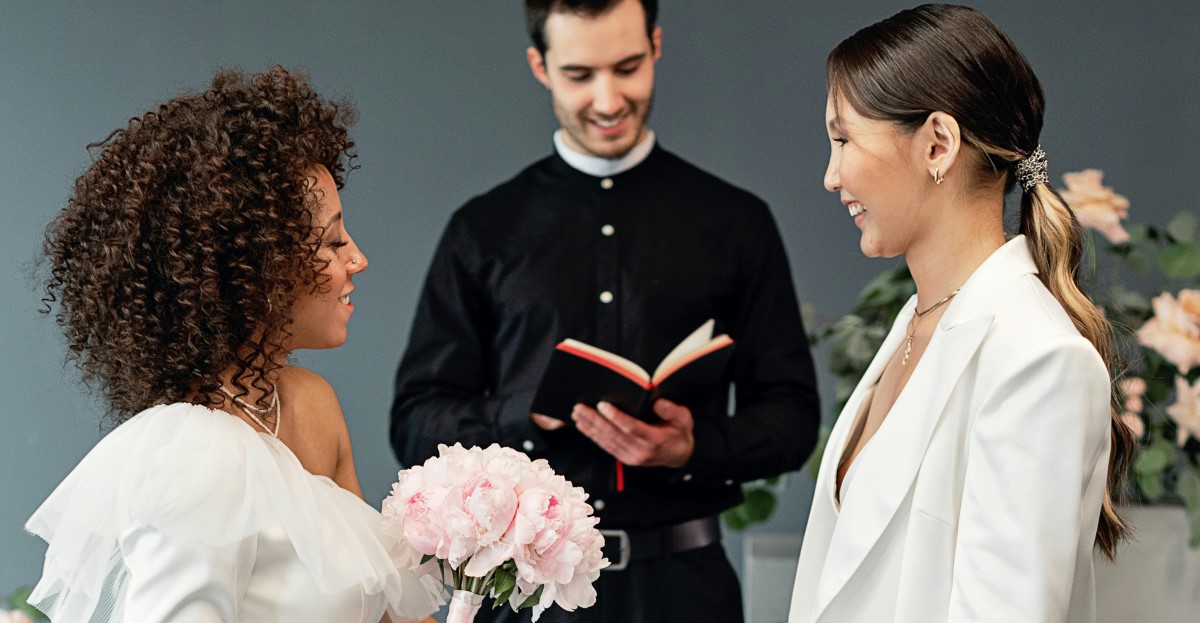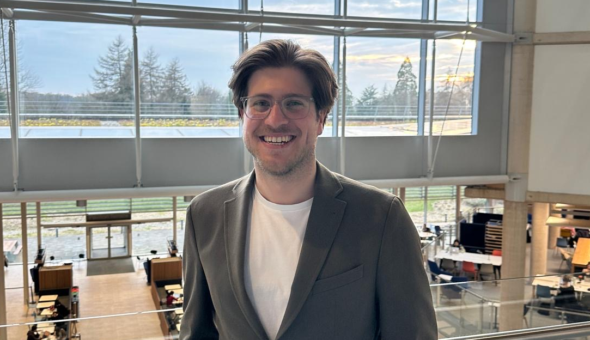Since the legalisation of same-sex marriage in the UK in 2014, how have couples negotiated, adapted or indeed transformed elements of a practice rooted in heteronormative meanings and traditions? In this LGBT+ History Month 2025 post, Dr Lorna Stevens explains her research into wedding rituals.
Rituals are formalised social practices laden with extraordinary, sacred meanings. They bring together the personal and the socio-cultural in an affirmation of social cohesiveness and belonging. Weddings are one such case – important, collective rituals that enable couples to show their commitment to one another.
They typically involve certain fixed, recognisable elements: a spectacle, certain artefacts (rings, flowers, costumes), an aisle, a particular script that culminates in the exchange of solemn vows, an officiant who presides over the ceremony and, of course, an audience.
As such, wedding rites are important forms of ‘display work’ that involve doing certain things in a certain order so that everyone there recognises what the rite is for. Given the deeply embedded assumptions about sex roles and gender, how might same sex-couples adapt or subvert traditional elements in their own wedding ceremonies?
To answer this question, myself and Dr Elizabeth Mamali interviewed 18 same-sex couples about their experiences. We asked them about their own special day, their motivation for having a marriage ceremony, which traditional elements they retained and how they ensured that their guests recognised that this was a profound wedding rite – albeit different from the heterosexual norm.
All the couples we interviewed perceived civil partnership as very different to marriage, and not held in the same esteem. There were also quite diverse experiences in relation to family acceptance, with many having had difficult experiences of coming out and even some being estranged from family. Having a wedding ceremony was thus an important ritual to signal to others that their union and commitment to one another was as important as that between a heterosexual couple.
In our research, we identified four tactics of what we term ‘reflexive display’ engaged in by same-sex couples.
Strategic compliance
This describes the use of traditional symbols and re-enactment of ritual scripts as significant means of legitimisation. For example, some of our participants – who were a male couple – decided to walk down the aisle in what was in every other respect an informal wedding ceremony:
“What we really didn’t want to do is have it too ‘wedding-y’. A lot of things associated to a wedding is what women do… [but] what we were really conscious of is people going, ‘Why do they have their friends marrying them? They didn't walk down an aisle. Are they married? What is this? This wasn’t very wedding-y.’”
Playful appropriation
This approach is where partners materially engage with – or at least make reference to – established and recognised rituals. This type of display work was especially prominent amongst female couples in our sample, who sought to appropriate certain gender norms in the lead up to their wedding.
One couple, for instance, described their decision to have a ‘stag do’:
“The whole thing was humour, it was basically funny, ironic. Because it was so not what we’re about, so it was a very deliberate pastiche of a very male tradition.”
Annexation tactics
These can demonstrate how important ritual artefacts are for display work. One of our interviewees had been cut off from his deeply religious African-American relatives for more than a decade, and none of his relatives attended the wedding. In their absence, he and his husband memorialised his kin connections during the ceremony, by engaging in the ‘jumping the broom’ ritual:
“The same broom has been in my family for years, from my great grandmother to my mother, everybody jumped the same broom. But I was not going to be allowed to use that broom… So we got our own broom. We decorated it ourselves, we made it look real nice and did our own thing. We gave a card to everybody before the ceremony to explain what it was and why we were doing it.”
Conspicuous absence
For some, a rejection of recognisable material elements in a wedding ritual was important. In contrast to those engaging in strategic compliance, some of our participants – particularly female couples – didn’t want to engage in walking down the aisle:
“One of my cousins’ daughters, it was her first ever wedding, so when the family received the wedding invitation… and my mum’s comment was, ‘Oh well, she’ll be disappointed because she expects the walking down the aisle bit.’ We said, ‘Really? If this is her first wedding maybe we can deconstruct the stereotypes a bit about what marriage is.’”
Together, these four display work positions show how the wedding rite can be done, undone or redone. Our study shows how same-sex partners negotiate identity, commitment and validation through their ceremony. Undoing and redoing normative traditions are equally powerful in this context.
Lastly, we show how different forms of display work can inform and indeed transform the wedding rite itself. The wedding rituals of our participants are the same but different, recognisable but transformed into something new, unique and significant for the couple.
Respond



